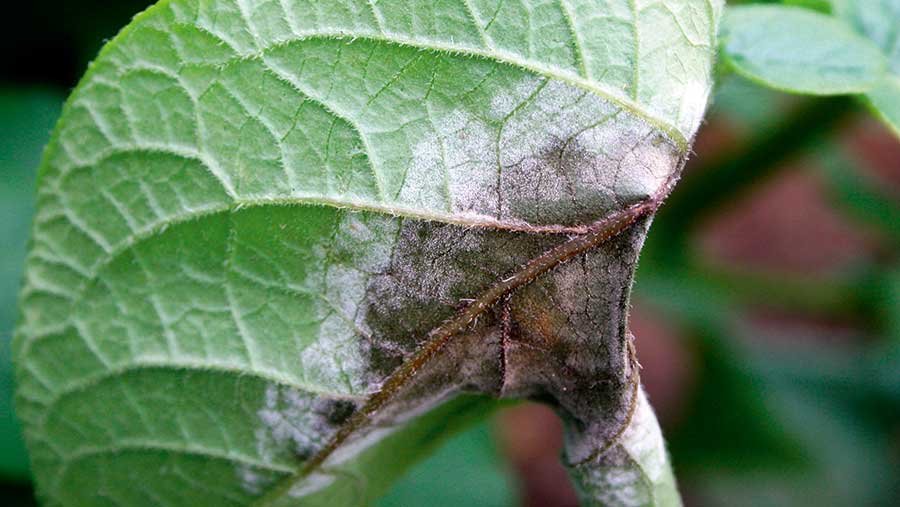How spud growers will benefit from blight forecasts
 © Blackthorn-Arable
© Blackthorn-Arable An improved method of predicting potato blight outbreaks is set to be launched next season, offering more reliable forecasts than the current Smith Period method, which it will replace.
New risk criteria for predicting outbreaks of the disease have been developed by researchers from the James Hutton Institute in Scotland.
Funding from AHDB Potatoes allowed the Scottish research team to examine the relationship between reported blight outbreaks and recorded Smith Periods, as well as consider changes in climate and blight populations, before coming up with the improved Hutton Criteria.
See also: How cover crops and chitting practices benefit spud growers
The main change is a reduction in the period of relative humidity at 90% or above, with the Hutton Criteria bringing this down to six hours. Previously, it stood at 11 hours.
These criteria will be built into blight prediction services for 2017, updating the 60-year-old Smith Period system, so that potato growers can expect to see a significant improvement in the reliability of blight risk prediction.
The Hutton Criteria v The Smith Period
Now: The Hutton Criteria
Two consecutive days:
- Each day has a minimum temperature of 10C
- Each day has at least six hours with relative humidity at or
above 90%
Then: The Smith Period
Two consecutive days:
- Each day has a minimum temperature of 10C
- Each day has at least 11 hours with relative humidity at or
above 90%
Smith Period shortcomings
As researcher Siobhan Roisin Dancey explains, Smith Periods have been very valuable in assessing blight risk over many years and were an advance on the Beaumont Criteria, which was used before 1956.
“However, what we found when we went through past records was that the Smith Period was not performing equally well in all parts of the country,” she says.
View from the field in 2016
Independent potato agronomist John Sarup of Spud Agronomy shares his blight experiences of regional variations from 2016:
- North – hardly any blight, 10-day spray intervals throughout
- East – blight started in August, controlled after a four-week period using robust treatments with curative activity
- West – blight started in early June and never stopped, had to switch to three- to four-day spray intervals
In addition, in recent seasons, some blight outbreaks were occurring before any conventional Smith Periods had been recorded, suggesting that the system was no longer offering the reliability that growers and agronomists needed.
Ms Dancey’s investigations looked at the thresholds for minimum temperature and relative humidity, as well as the duration of high relative humidity.
“This duration is the key point,” she stresses. “We found that the minimum temperature of 10C should not change, nor should the relative humidity threshold of 90%.”
“But whereas each day had to have at least 11 hours with a relative humidity of 90% or above in the Smith Period method, the Hutton Criteria has changed that to at least six hours.”
Better predictions
Applying the Hutton Criteria to historic blight outbreaks saw performance rise from 41% to 69%, with more outbreaks receiving alerts.
There was also better consistency in alert performance across all regions of the country.Better predictions
“What we now have is an improved decision support tool for blight management, which can be used next season to help identify high-risk periods and so protect potato crops,” says Ms Dancey.
The Hutton Criteria should be applicable for the foreseeable future, notes David Cooke of the Hutton Research Institute.
“While we can’t predict what will happen with the new genotypes, we aren’t anticipating a dramatic change in the way that blight responds to temperature and relative humidity,” he says.
Blight Population Dynamics Update
Blight outbreaks in British crops in 2016 were mostly caused by the dominant strains 6_A1 and 13_A2, reports David Cooke of the James Hutton Institute.
That echoes the previous season, prompting Dr Cooke to point out that there is very little diversity in England compared with other parts of Europe.
“It’s mostly all about the devil we know. However, there have been continued observations of a new clone 36_A2 in mainland Europe, so we must be vigilant and aware of what’s on the horizon.”
Here, there has been a slight increase in 23_A1, which Dr Cooke describes as rare and interesting, while a new strain, 37_A2, was found in just five outbreaks.
“The 33_A2, or green 33 clone, which shows fluazinam insensitivity, hasn’t been seen for three years, but that doesn’t mean it has gone away.”
In Scotland, there are more novel types and there is data to support oospore inoculum, he adds.
“But there is no evidence of any spread of novel types between seasons or out of the region.”

